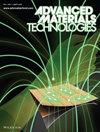用于生物医学应用的单壁碳纳米管光学纳米/生物传感器:在生物成像、疾病诊断和生物标记检测中的作用
IF 6.4
3区 材料科学
Q1 MATERIALS SCIENCE, MULTIDISCIPLINARY
引用次数: 0
摘要
先进纳米技术与疾病诊断技术的融合开创了医疗保健领域的变革时代,使疾病的早期准确检测成为可能,并为及时干预、改善治疗效果和提高患者福利铺平了道路。新型材料的开发往往是传感器技术取得重大进展的推动力。其中,单壁碳纳米管(SWCNTSs)已成为开发生物传感器的前景广阔的纳米材料。单壁碳纳米管具有独特的光学、电学和生物相容性,因此有望提高生物传感器的灵敏度和实时监测能力,并实现各种生物成像技术。最近的研究表明,基于 SWCNTS 的生物传感器可用于实时监测一氧化氮和过氧化氢 (H2O2) 等生物分析物,对了解疾病和评估治疗反应具有潜在意义。此外,SWCNTS 在生物成像应用方面也大有可为,包括生物样本的荧光、拉曼光谱和光致发光成像。本文深入探讨了基于 SWCNTS 和生物成像技术的生物传感器的核心原理、设计策略和运行机制。文章强调了碳纳米管的独特性质和多功能性,为将其集成到生物传感器平台和应用中奠定了基础,这些平台和应用旨在诊断包括传染病、癌症、神经系统疾病和代谢疾病在内的多种疾病。本文章由计算机程序翻译,如有差异,请以英文原文为准。

Single‐Walled Carbon Nanotube‐Based Optical Nano/Biosensors for Biomedical Applications: Role in Bioimaging, Disease Diagnosis, and Biomarkers Detection
The convergence of advanced nanotechnology with disease diagnosis has ushered in a transformative era in healthcare, empowering early and accurate detection of diseases and paving the way for timely interventions, improved treatment outcomes, and enhanced patient well‐being. The development of novel materials is frequently the impetus behind significant advancements in sensor technology. Among them, single‐walled carbon nanotubes (SWCNTSs) have emerged as promising nanomaterials for developing biosensors. Their unique optical, electrical, and biocompatibility properties make them promising candidates for enhancing the sensitivity and real‐time monitoring capabilities of biosensors, as well as for enabling various bioimaging techniques. Recent studies have demonstrated the utility of SWCNTS‐based biosensors in the real‐time monitoring of biological analytes, such as nitric oxide and hydrogen peroxide (H2O2), with potential implications for disease understanding and therapeutic response assessment. Moreover, SWCNTSs have shown promise in bioimaging applications, including fluorescence, Raman spectroscopy, and photoluminescence imaging of biological samples. This article delves into the core principles, design strategies, and operational mechanisms that underpin SWCNTS‐bioimaging techniques‐based biosensors. It emphasizes on their unique properties and versatile functionalization of carbon nanotubes, laying the foundation for their integration into biosensor platforms and applications aimed at diagnosing a wide spectrum of diseases including infectious diseases, cancer, neurological disorders, and metabolic conditions.
求助全文
通过发布文献求助,成功后即可免费获取论文全文。
去求助
来源期刊

Advanced Materials Technologies
Materials Science-General Materials Science
CiteScore
10.20
自引率
4.40%
发文量
566
期刊介绍:
Advanced Materials Technologies Advanced Materials Technologies is the new home for all technology-related materials applications research, with particular focus on advanced device design, fabrication and integration, as well as new technologies based on novel materials. It bridges the gap between fundamental laboratory research and industry.
 求助内容:
求助内容: 应助结果提醒方式:
应助结果提醒方式:


